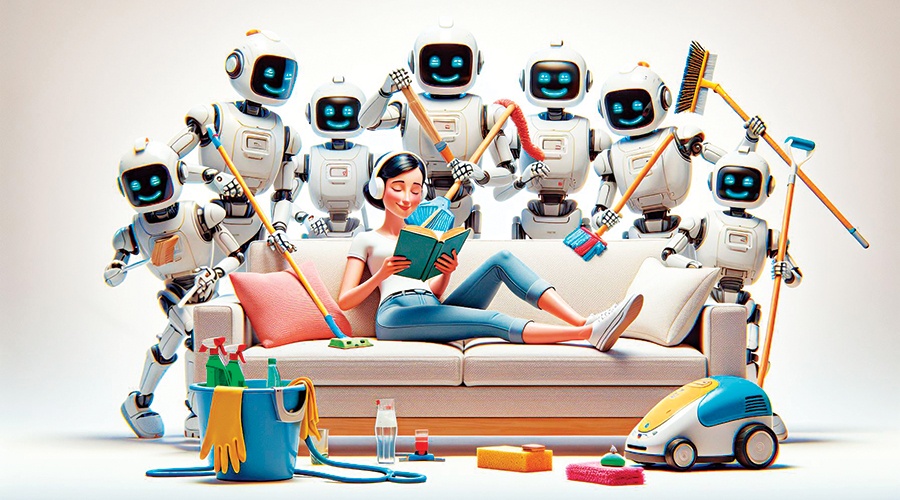15 Artificial Intelligence Tools to Experiment with at Home

Need help drafting an email or washing your windows? There’s an invention for that.
AI is here to help. Or so it says. / Generated by Benjamen Purvis using AI
IF YOU NEED…
To Create Something
TRY THESE ➔
ChatGPT
Need some help writing an email or birthday card? Every week, more than 100 million people already rely on OpenAI’s generative chatbot to craft missives, shopping lists, essays, and more. Capable of processing natural human languages and inferring intention, ChatGPT comes in both free and paid versions and works best when treated as a conversation partner. To get started on good footing, try giving the chatbot a prompt that includes details of what you want the outcome to look like. (For example: You might ask for a stew recipe and cite the ingredients that you already have on hand.) “Once you get an initial answer, then you start asking it to refine its answer by giving it more information and guiding it toward what you’re looking for,” explains Michael Oh, founder and president of Boston-based TSP Smart Spaces, which integrates homes with smart technology.
Google Gemini
Another versatile workhorse of a chatbot, Google Gemini can scan the Internet for the most recent information to craft its answers to your prompts or questions. (ChatGPT is still catching up on pulling more recent data from the web than its circa-2021 training.) Not only does this yield meatier responses than the ones you’ll get from the free version of ChatGPT, but Gemini also offers more user options for modifying and reformatting responses. The catch is that Gemini’s writing skills are lagging behind ChatGPT, so consider using this platform for research first, and be prepared to personally polish up any Gemini-generated content that you plan on presenting to an audience.

Generated by Benjamen Purvis using AI
DALL·E 2
Composing text is just the beginning when it comes to the generative powers of AI. With OpenAI’s visual-centric DALL·E 2 platform, you can create customized images using word prompts. The process is similar to ChatGPT and Google Gemini—once your first image is created, you can tweak it by modifying the prompt. Let’s say you want an image of a blue whale crooning into a microphone. (Just go with it.) You can change the prompt to soften the color of the whale, enlarge the whale, or turn a modern-day microphone into a World War II–era microphone. It’s all your call.
Socratic by Google
While generative AI poses troubling questions for families and educators—will kids use AI to do the heavy lifting on their homework and projects in the future?—Google is beginning to address these concerns with Socratic, a learning-centric chatbot with guardrails. Socratic won’t write essays or stories, but it will answer any questions that a student might have about what they’re studying, with conversational language and helpful graphics.

Generated by Benjamen Purvis using AI
IF YOU NEED…
Entertainment and Well-Being
TRY THESE ➔
Virtual Reality Goggles
Stuck at home and bored on a Tuesday evening? Feel like sprucing up your white-walled living room with vines, hummingbirds, and some ethereal cascades? Apple Vision Pro goggles ($3,499) allow you to superimpose digital images on physical settings, and with the integration of Adobe’s Firefly AI, you can create the digital images with your own prompts and then refine them.
Smart Glasses
If you’ve ever felt the urge to capture a face-melting concert or an epic sunset—without pulling out your phone—you might want to pony up for Ray-Ban’s “Meta Wayfarer” glasses (starting at $316). Pairing classic frames with Meta AI, these smart glasses can be used to record videos and stream music on the go. They also include a multimodal search function to help with spontaneous tasks like identifying birds or plants, finding nearby restaurants, or crafting social media captions for your photos.
Multifunction Mirrors
What if your bedroom mirror could be a portal to personal training sessions and more than 700 fitness classes, all while tracking your progress to help you reach your wellness goals? The Forme Studio smart mirror ($2,495, plus a monthly subscription) packs all of these features into one elegant package.
AI-Powered Mattresses
Sleeping poorly and waking up sore every morning? It might be time for a new mattress. ErgoSportive’s adjustable smart bed (starting at $3,599) uses personalized sleep data to physically adjust its shape and better accommodate your sleeping position(s).

Generated by Benjamen Purvis using AI
IF YOU NEED…
EXTRA HELP AT HOME
TRY THESE ➔
Roomba Cleaning Robot
What It Is: Among the earliest AI consumer products, iRobot’s famous roaming vacuums and mops have only gotten better at removing dirt and debris from floors and carpets. The iconic cleaning machines can now cover larger rooms and dodge more obstacles, and they’re even capable of emptying their detritus and replenishing their water reserves.
Why You Should Use It: Because programming your floors to be cleaned via iRobot’s Home app is a million times easier than vacuuming every night.
Cost: Starting at $275.
Hobot Window-Cleaning Robot
What It Is: HOBOT’s window-cleaning (and -climbing!) robots keep your glass clean with a patented design that includes an ultrasonic water spray nozzle and built-in microfiber cloth. Simply fill it with water or detergent, plug it in with the included extra-long power cord, and watch it go to town.
Why You Should Use It: Once your automated window-cleaning buddy gets going, you can leave it alone, devote your time to more interesting things, and get notified when the job is done with the Hobot app.
Cost: Starting at $479.
Husqvarna Automower
What It Is: Imagine a battery-powered robot rolling around your lawn, quietly trimming the grass, and you’ll have a pretty clear picture of the Automower.
Why You Should Use It: Mowing your lawn by hand can be physically cumbersome. Plus, the Automower can perform this task without the noise (or the emissions) of manual mowing.
Cost: Starting at $899.
AI-Powered Robotic Arms
What They Are: Today, robotic arms, which can be mounted to wheelchairs to help people with disabilities complete daily tasks, are still manually controlled. AI will change this by automating every movement.
Why You Should Use Them: Current robotic arms tend to be slower and difficult to control when performing tasks such as opening doors. Not only will the intuitive power of AI address these shortcomings, but the absence of manual controls could make them accessible to a wider range of people.
Cost: TBD, but for context, contemporary AI-free robotic arms can cost upward of $20,000.

Generated by Benjamen Purvis using AI
IF YOU NEED…
Financial Help
TRY THESE ➔
Keeping money in order is still vexing for many of us, but AI-powered finance-management apps are helping to demystify the process. Cleo, a financial-planning chatbot, can assess your bank and credit card accounts and help you determine how much you’ll need to squirrel away for a splurge like a new car or a getaway. Saving for retirement? Consider consulting Magnifi, which suggests funds and investment products that can diversify your portfolio. And if you’re trying to stop getting dinged by paid subscriptions that you forgot to cancel, Rocket Money can keep track of all your recurring payments in one place and nix the subscriptions that you don’t need anymore.

Boston’s AI Revolution
-
- Where We Are and How We Got Here
- The Trailblazers: Who Got Us Here and How
- AI From 9 to 5: How Work Will Change Forever
- Risks & Fears: Be Afraid—but Not Too Afraid
First published in the print edition of the April 2024 issue, as part of an AI cover package, with the headline, “Boston’s AI Revolution.”



